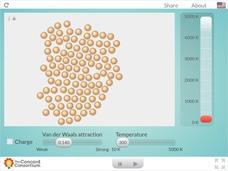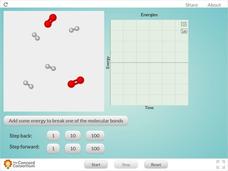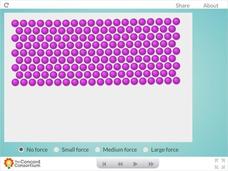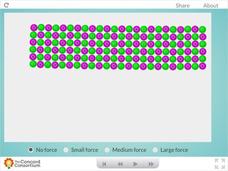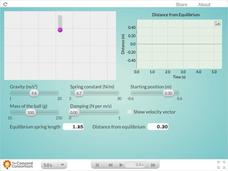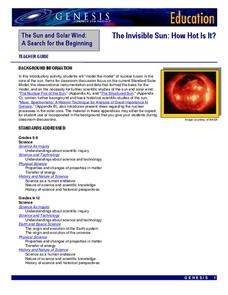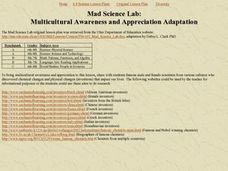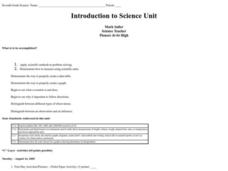Concord Consortium
Gas Molecules in Motion
Get moving! Science scholars observe the effects of temperature on kinetic energy in an impactful interactive. Individuals control a sliding temperature switch and observe the motion of gas particles that results from the change.
Concord Consortium
Oil and Water
If you don't get along with someone, it's said that the two of you are like oil and water. Why is this? Explore the phenomenon and explain the phrase in one resource! Science superstars first observe samples of oil and water together....
Concord Consortium
Charged and Neutral Atoms
Do charged and neutral particles behave differently as they undergo phase changes? Science sleuths examine two types of attractive forces using an informative interactive. Pupils can vary the amount of Van der Waals attraction present...
Concord Consortium
Intermolecular Attractions and States of Matter
Need a solid resource for teaching about states of matter? Science scholars go with the flow in a simple interactive that shows how intermolecular attractions determine a substance's phase. Pupils take control of the level of attraction...
Concord Consortium
Reaction Between Hydrogen and Oxygen Molecules
When molecules of hydrogen and oxygen are combined, how does water form? Science scholars observe changes in kinetic and potential energy during a chemical reaction in an interactive. The resource features easy controls that allow users...
Concord Consortium
Visualizing Electric Fields and Forces
Shock your class with an exciting interactive about electric fields! Physical science superstars visualize the transparent world of electric fields by changing the charge on a stationary object. They then observe changes in the resulting...
Concord Consortium
Direction of Force on Charged Objects
Make your unit on magnetism a force to be reckoned with! Physical science scholars examine the direction of force on charged objects through a simple interactive. Pupils control the charge of the stationary object, then observe how it...
Concord Consortium
Energy of a Pendulum
Just a swingin'! Introduce physical science scholars to the energy forms associated with a pendulum using a simple interactive. Learners adjust the height from which the pendulum starts, then observe changes in potential, kinetic, and...
Concord Consortium
Metal Forces
Are you all bent out of shape, trying to find a great resource that illustrates the properties of metals? Show science scholars the unique world of metallic bonding with a hands-on activity. Users apply three levels of force to a sample...
Concord Consortium
Ceramic Forces
Why are bricks more likely to break than bend? Young science scholars peer inside a ceramic block and examine the effects of downward force at the molecular level. Learners can apply three different levels of force before observing their...
Concord Consortium
Spring and Mass
Here's a resource with more bounce for the ounce! Engage your physical science class with an interesting interactive that allows individuals to perform tests with a mass attached to a spring. Participants can customize the scenario by...
Concord Consortium
Pendulum
Add some zing to your swing! Explore pendulum motion through an engaging interactive. Physical science scholars specify the pendulum's mass, rod length, and starting angle before they observe the resulting angle graph.
Concord Consortium
Collisions and Kinetic Energy
Can your physical science classes describe what happens when two objects collide? Whether they are new to the study of kinetic energy or just brushing up on their skills, pupils can observe the outcome of a variety of collisions...
NASA
The Invisible Sun: How Hot Is It?
It's getting hot in here! The first in a series of six lessons has learners model nuclear fusion with a simple lab investigation. Groups collect data and analyze results, comparing their models to the actual process along the way.
Odell Education
Plant and Animal Cells
Incorporate multiple facets of the cell into your next high school lab! Through an introduction to cell organelles, class members observe each cell type and draw visuals to further demonstrate understanding of cellular processes in both...
Curated OER
Lab Activity: Model of the Planets
This worksheet leads the class through the calculations needed to construct circles to represent the planets of our Solar System. The actual values are provided, as are suggested calculations to create the scale diameters. The ten...
Curated OER
Stars Lab
After making a list of top 10 brightest stars, your class will learn to classify the colors of the hottest and coolest stars. The spectral classes will help with understanding of nuclear fusion and the life of a star.
Science Matters
Celery Lab
See firsthand the work plants do to move nutrients through their systems with a instructional activity that demonstrates the role of the xylem and phloem in plants. Young scientists observe celery move colored water through its stem to...
Curated OER
Mad Science Lab
Students explore a number of activities that are focused on the process of learning using many different types of strengths. The strengths are classified using Howard Gardner's Theory of Multiple Intelligences.
Curated OER
Mad Science Lab
Students participate in a research assignment to find out the accomplishments of famous scientists from diverse backgrounds and cultures. The lesson strengthens a commitment to multicultural education.
Curated OER
Introduction to Science
Seventh graders investigate scientific methods to solve problems. They demonstrate creating data tables and graphs. They study the role of a scientist and the importance of safety in a science lab. They distinguish between an...
Curated OER
Exploring Great Salt Lake Ecosystem
Fourth graders determine the Great Salt Lake is a unique, thriving, and diverse ecosystem. They engage in an actual or a virtual field trip. They record field trip, whether actual or virtual, in science lab book or journal and...
Curated OER
CSI, Second Grade Style
Second graders conduct a classroom investigation. In this investigative lesson, 2nd graders spend their time observing, measuring, and collecting data. They simulate a forensic science lab by conducting a fingerprint, scent, footprint,...
Curated OER
Science Lab Skills
Pupils develop problem solving, decision-making and inquiry skills by planning experiments. They conduct systematic observations, interpret and analyze data and draw conclusions then communicate their results.
Other popular searches
- Science Lab Safety Rules
- Science Lab Safety
- Environment Science Labs
- Physical Science Lab Safety
- Forensic Science Lab
- Teaching Science Lab Safety
- Science Lab Equipment
- Science Lab Report
- Simple Science Lab Report
- Science Lab Safety Symbols
- Physical Science Labs
- Science Lab Report Templates


